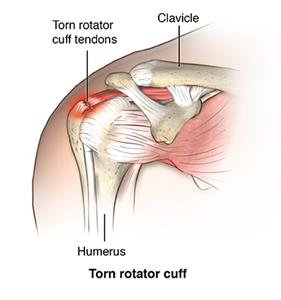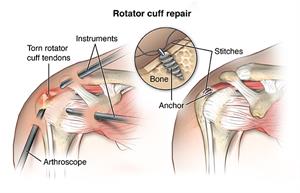Rotator Cuff Repair
What is a rotator cuff repair?
The rotator cuff consists of muscles and tendons that hold the shoulder in place. It’s one of the most important parts of the shoulder. It allows you to lift your arm and reach up. An injury to the rotator cuff, such as a tear, may happen suddenly when falling on an outstretched hand or develop over time due to repetitive activities. Rotator cuff degeneration and tears may also be caused by aging.

If your rotator cuff is injured, you may need to repair it surgically. This may include shaving off bone spurs that are pinching the shoulder, or repairing torn tendons or muscles in the shoulder. Surgical techniques that may be used to repair a tear of the rotator cuff include arthroscopy, open surgery, or a combination of both. The goal of rotator cuff repair surgery is to help restore the function and flexibility of the shoulder and to relieve the pain that can’t be controlled by other treatments.
Why might I need a rotator cuff repair?
Shoulder injuries are common. Athletes and construction workers often have rotator cuff injuries due to repetitive movement and overuse of the shoulder. The rotator cuff may be damaged from a fall or other injury to the shoulder. Damage may also occur slowly over time. The damage may be due to:
- Strains or tears in the rotator cuff.
- Inflammation of the bursa (bursitis) in the shoulder.
- Inflammation of the tendons (tendinitis) in the shoulder.

Recurrent pain, limited ability to move the arm, and muscle weakness are the most common symptoms.
If medical treatments are not satisfactory, rotator cuff repair surgery may be an effective treatment. Medical treatments for rotator cuff injury may include, but are not limited to, the following:
- Rest
- Non-steroidal anti-inflammatory medications
- Strengthening and stretching exercises
- Steroid injections
Rotator cuff surgery may be performed using an arthroscope. An arthroscope is a small, tube-shaped instrument that is inserted into a joint. It consists of a system of lenses, a small video camera, and a light for viewing. The camera is connected to a monitoring system that allows the doctor to view a joint through a very small incision. The arthroscope is often used along with other tools that are inserted through another incision.
An open repair may be performed if the rotator cuff injury can’t be repaired using arthroscopy. In some cases, a tendon graft and joint replacement may be needed.
There may be other reasons for your healthcare provider to recommend rotator cuff repair.
What are the risks of a rotator cuff repair?
As with any surgical procedure, complications can occur. Some possible complications may include:
- Bleeding
- Infection
- Blood clots in the legs or lungs
The joint pain may not be relieved by the surgery. You may not recover full range of motion in the shoulder joint.
Nerves or blood vessels in the area of surgery may be injured, resulting in weakness or numbness.
There may be other risks depending upon your specific medical condition. Be sure to discuss any concerns with your healthcare provider prior to the procedure.
How do I get ready for a rotator cuff repair?
- Your healthcare provider will explain the procedure to you and offer you the chance to ask any questions that you might have about the procedure.
- You will be asked to sign a consent form that gives your permission to do the procedure. Read the form carefully and ask questions if something is not clear.
- In addition to a complete medical history, your healthcare provider may perform a complete physical exam to ensure you are in good health before undergoing the procedure. You may undergo blood tests or other diagnostic tests.
- Tell your healthcare provider if you are sensitive to or are allergic to any medications, latex, tape, and anesthetic agents (local and general).
- Tell your healthcare provider of all medications (prescribed and over-the-counter) and herbal supplements that you are taking.
- Tell your healthcare provider if you have a history of bleeding disorders or if you are taking any anticoagulant (blood-thinning) medications, aspirin, or other medications that affect blood clotting. It may be necessary for you to stop these medications prior to the procedure.
- If you are pregnant or suspect that you are pregnant, you should notify your healthcare provider.
- You will be asked to fast for 8 hours before the procedure, generally after midnight.
- You may receive a sedative prior to the procedure to help you relax. Because the sedative may make you drowsy, you will need to arrange for someone to drive you home.
- You may meet with a physical therapist prior to your surgery to discuss rehabilitation.
- Based upon your medical condition, your healthcare provider may request other specific preparation.
What happens during a rotator cuff repair?
Rotator cuff repair may be done on an outpatient basis or as part of your stay in a hospital. Procedures may vary depending upon your condition and your doctor’s practices.
Rotator cuff repair may be done while you are asleep under general anesthesia, or while you are awake under local or regional anesthesia. If regional anesthesia is used, you will have no feeling in your shoulder. The type of anesthesia will depend upon the specific procedure being done. Your doctor will discuss this with you in advance.
Generally, rotator cuff repair surgery follows this process:
- You will be asked to remove clothing and will be given a gown to wear.
- An intravenous (IV) line may be started in your arm or hand.
- You will be positioned on the operating table.
- The anesthesiologist will continuously monitor your heart rate, blood pressure, breathing, and blood oxygen level during the surgery.
- The skin over your surgical site will be cleansed with an antiseptic solution.
- Your doctor will make an incision in the shoulder area. The incision will vary depending upon the type of surgery (open surgery, arthroscopy, or a combination of both) that may be done.
- The arthroscope (if used) will be inserted through the incision.
- Other incisions may be made to introduce other small grasping, probing, or cutting tools.
- Injured tendons and muscles will be repaired or replaced with a graft tendon from another part of the body.
- Bone spurs (if present) will be removed.
- The incision(s) will be closed with stitches or surgical staples.
- A sterile bandage/dressing will be applied.

What happens after a rotator cuff repair?
After surgery you will be taken to the recovery room for observation. Your recovery process will vary depending upon the type of anesthesia that is given and the type of surgery that’s done. The circulation and sensation of your arm will be monitored. Once your blood pressure, pulse, and breathing are stable and you are alert, you will be taken to your hospital room or discharged to your home.
You may be given an immobilizer or sling before you go home.
Once you’re home, it’s important to keep the surgical area clean and dry. Your healthcare provider will give you specific bathing instructions. The stitches or surgical staples will be removed during a follow-up office visit.
Take a pain reliever for soreness as recommended by your healthcare provider. Aspirin or certain other pain medications may increase the chance of bleeding. Be sure to take only recommended medications.
To help reduce swelling, you may be asked to apply an ice bag to the shoulder several times per day for the first few days. You should keep the sling or immobilizer on as directed by your healthcare provider.
Your healthcare provider will arrange for an exercise rehabilitation program to help you regain muscle strength, flexibility, and function of your shoulder.
Notify your healthcare provider to report any of the following:
- Fever
- Redness, swelling, bleeding, or other drainage from the incision site
- Increased pain around the incision site
- Numbness or tingling in the affected arm or hand
You may resume your normal diet unless your healthcare provider advises you differently.
You should not drive until your healthcare provider tells you to. Other activity restrictions may apply. Full recovery from the surgery may take several months.
Your healthcare provider may give you additional or alternate instructions after the procedure, depending on your particular situation.
Next steps
Before you agree to the test or the procedure make sure you know:
- The name of the test or procedure
- The reason you are having the test or procedure
- The risks and benefits of the test or procedure
- When and where you are to have the test or procedure and who will do it
- When and how will you get the results
- How much will you have to pay for the test or procedure
Online Medical Reviewer: Foster, Sara, RN, MPH
Online Medical Reviewer: Freeborn, Donna, PhD, CNM, FNP
Date Last Reviewed: 1/30/2014
© 2000-2016 The StayWell Company, LLC. 780 Township Line Road, Yardley, PA 19067. All rights reserved. This information is not intended as a substitute for professional medical care. Always follow your healthcare professional's instructions.